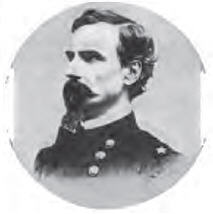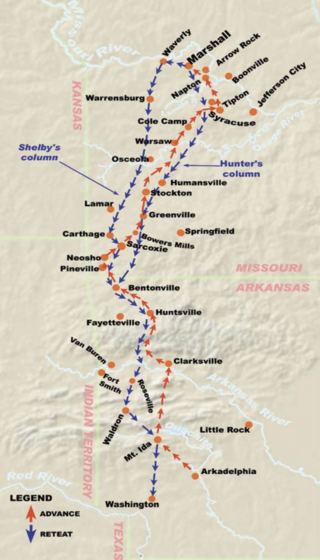
James Harrison Wilson was an American military officer, topographic engineer and a Major General in the Union Army during the American Civil War. He initially served as an aide to Major General George B. McClellan during the Maryland Campaign before joining Major General Ulysses S. Grant's army in the Western Theater, where he was promoted to brigadier general. In 1864, he transferred from engineering to the cavalry, where he displayed notable leadership in many engagements of the Overland Campaign. However, his attempt to destroy Lee’s supply lines failed when he was routed by a much smaller force of Confederate irregulars.

Thomas Taylor Munford was an American farmer, iron, steel and mining company executive and Confederate colonel and acting brigadier general during the American Civil War.
The 4th Kentucky Infantry Regiment was an infantry regiment that served in the Union Army during the American Civil War.
Wilson's Raid was a cavalry operation through Alabama and Georgia in March–April 1865, late in the American Civil War. U.S. Brig. Gen. James H. Wilson led his U.S. Cavalry Corps to destroy Confederate manufacturing facilities and was opposed unsuccessfully by a much smaller force under Confederate Lt. Gen. Nathan Bedford Forrest.

John Thomas Wilder was an officer in the Union Army during the American Civil War, noted principally for capturing the critical mountain pass of Hoover's Gap during the Tullahoma Campaign in Central Tennessee in June 1863. Wilder had personally ensured that his "Lightning Brigade" of mounted infantry was equipped with the new Spencer repeating rifle. However, Wilder initially had to appeal to his men to pay for these weapons themselves before the government agreed to carry the cost. The victory at Hoover's Gap was attributed largely to Wilder's persistence in procuring the new rifles, which disoriented the enemy.

John Wynn Davidson was a brigadier general in the United States Army during the American Civil War and an American Indian fighter. In 1850, he co-led the Bloody Island massacre of 60-200 Pomo old men, women, and children as part of the wider California genocide.

John Thomas Croxton was an attorney, a general in the United States Army during the American Civil War, and a Reconstruction era U.S. diplomat.
2nd Arkansas Light Artillery, (1860–1865) was a Confederate Army artillery battery which served during the American Civil War. The battery spent the majority of the war serving in Confederate forces east of the Mississippi River. The battery is also referred to as the Clark County Artillery, Robert's Arkansas Battery and Wiggins Arkansas Battery.

Shelby's Raid, also known as Shelby's Great Raid, was a Confederate cavalry incursion into Arkansas and Missouri during the American Civil War in 1863. Led by Colonel Joseph Orville Shelby, the raid took place from August 21, 1863, to November 3, 1863, covering over 800 miles across territories in west central and northwest Arkansas, as well as southwest and west central Missouri.

The 72nd Indiana Infantry Regiment, also known as 72nd Indiana Mounted Infantry Regiment, was an infantry and mounted infantry regiment that served in the Union Army during the American Civil War. The regiment served as mounted infantry from March 17, 1863, to November 1, 1864, notably as part of the Lightning Brigade. during the Tullahoma and Chickamauga Campaigns.
The Battle of Columbus, Georgia, was the last conflict in the Union campaign through Alabama and Georgia, known as Wilson's Raid, in the final full month of the American Civil War.
The 3rd Arkansas Light Artillery, also known as the Jackson Light Artillery (1861–1865), was a Confederate Army artillery battery during the American Civil War. The battery spent the majority of the war serving in Confederate forces east of the Mississippi River. The battery is also known as McCown's Battery, Hubbard's Battery, and Thrall's Battery in official reports.
The 46th Arkansas Infantry (Mounted) (1864–1865) was a Confederate Army Mounted Infantry regiment during the American Civil War. While authorized by the State Military Board as an infantry regiment, the unit was mounted for Price's Missouri Expedition and served as mounted infantry. Due to its mounted status, the unit is sometimes referred to as the 46th Arkansas Cavalry when a numerical designation is used. The unit is almost always referred to as either Coleman's Arkansas Cavalry Regiment or Crabtree's Cavalry in official reports from the period.
The 47th Arkansas Infantry (Mounted) (1864–1865) was a Confederate Army Mounted Infantry regiment during the American Civil War. While authorized by the State Military Board as an infantry regiment, the unit was mounted for Price's Missouri Expedition and was officially designated as mounted infantry. Due to its mounted status, the unit is sometimes referred to as the 47th Arkansas Cavalry when a numerical designation is used. The unit is most often referred to as Crandell's Arkansas Cavalry Regiment, after its commander Colonel Lee Crandell.
The 8th Arkansas Field Battery (1862–1865) was a Confederate Army artillery battery during the American Civil War. The battery spent its entire existence in the Department of the Trans-Mississippi. It was also known as Hughey's Battery.

The 1st Florida Infantry Regiment was an infantry regiment raised by the Confederate state of Florida during the American Civil War. Raised for 12 months of service its remaining veterans served in the 1st (McDonell's) Battalion, Florida Infantry from April 1862 on. In August the depleted battalion was consolidated with the 3rd (Miller's) Battalion into the reorganized 1st Florida Infantry Regiment again. In December 1862 it merged with the 3rd Florida Infantry Regiment and received the form it kept till the war's end as the 1st and 3rd Consolidated Florida Infantry Regiment. Fighting as part of the Army of Tennessee in the Western Theater of the American Civil War it was surrendered on April 26, 1865.
The 51st United States Colored Infantry Regiment was an infantry regiment composed of African-American troops recruited from Mississippi that served in the Union Army during the American Civil War. Initially formed in the spring of 1863 as the 1st Regiment Mississippi Volunteer Infantry (African Descent), the Regiment took part in fierce fighting at the Battle of Milliken's Bend, served on garrison duty in Louisiana, and then took part in the Battle of Fort Blakeley, the last major battle of the war.
The Battle of Camp Davies was a skirmish during the American Civil War on November 22, 1863, near a Union Army camp about six miles south of Corinth, Mississippi. A 70-man detachment of the 1st Regiment Alabama Cavalry (Union), commanded by Major Francis L. Cramer, drove off a 150-man Confederate force of the 16th Battalion, Mississippi Cavalry State Troops, commanded by Major Thomas W. Ham, and killed at least 4 Confederate soldiers, while suffering two severely wounded troopers. This action is the only engagement recorded as occurring at or near Camp Davies in major sources on American Civil War battles. Other similar engagements in the vicinity of Corinth in 1863 may have occurred near Camp Davies.
Wirt Adams' Cavalry Regiment was a unit of the Confederate States Army during the American Civil War, composed of cavalry companies from Mississippi, Alabama, and Louisiana. Originally titled the First Regiment of Mississippi Cavalry, the unit was renamed after its commander, William Wirt Adams, in December, 1861. After Adams was promoted to Brigadier general in 1863, the unit was renamed Wood's Regiment, but it is most commonly known in historical sources as Wirt Adams' Cavalry. The regiment fought in various battles in Mississippi and Tennessee, and spent the second half of the war operating in the Mississippi Delta, opposing Federal cavalry raids after Union forces took control of most of the strategic points in that state. The Regiment surrendered in Alabama on May 4, 1865.
The 56th Alabama Cavalry was a Confederate Partisan Ranger cavalry regiment from Alabama. Initially organized as 2 separate Partisan Ranger battalions, the 56th Regiment was created in the summer of 1863 and took part in several campaigns of the Western Theater of the American Civil War before surrendering in the spring of 1865.












